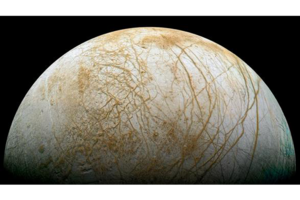What should we take to Europa? NASA picks science instruments.
For its mission to Europa, NASA plans on bringing instruments to scan the surface and analyze the water of Jupiter's icy moon.

Europa imaged by NASA's Galileo spacecraft.
NASA/JPL-Caltech/SETI Institute
Sen—Science instruments have been chosen for a NASA mission to Jupiter's icy moon Europa to discover if it has conditions suitable for alien life.
Evidence that the moon has a sub-surface ocean was first provided by NASA's Galileo probe which orbited Jupiter between 1995 and 2003. More recently, the Hubble Space Telescope detected water vapour up to 201 km (125 miles) above Europa's south polar region, suggesting that water plumes are bursting into space through the moon's icy crust.
“Europa has tantalized us with its enigmatic icy surface and evidence of a vast ocean, following the amazing data from 11 flybys of the Galileo spacecraft over a decade ago and recent Hubble observations suggesting plumes of water shooting out from the moon," said NASA's John Grunsfeld, in a statement.
“We’re excited about the potential of this new mission and these instruments to unravel the mysteries of Europa in our quest to find evidence of life beyond Earth.”
The proposed mission is for a spacecraft to orbit Jupiter and study Europa over a three year period by making 45 flybys of the moon, swooping as low as 25 km (16 miles) above the surface.
NASA's 2016 budget request includes $30 million allocated for mission design.
The instruments selected for the mission include cameras and spectrometers that can determine the composition of the surface, and radar that can measure the thickness of the icy crust and detect the existence of the underground ocean or sub-surface lakes.
A magnetometer has also been chosen to analyse the moon's magnetic field, from which scientists will be able to analyse the saltiness and depth of underground water.
There will also be instruments to search for water plumes and water vapor in the atmosphere.
Europa is one of the four Galilean moons discovered by Galileo Galilei in 1610, the others being Ganymede, Callisto and Io.
Though the smallest of the four Galilean moons, with a diameter of 3,122 km (1,940 miles) Europa is still the sixth largest satellite in the Solar System.
Meanwhile NASA's Juno spacecraft is due to arrive at Jupiter in July 2016. The probe will enter a low polar orbit with the aim of better understanding Jupiter's formation and structure as well as studying the planet’s dynamic aurorae.
The European Space Agency are also working on a mission to study Europa, as well as Ganymede and Callisto, with its Jupiter Icy Moons Explorer (JUICE). The spacecraft is due to launch in 2022 and arrive at the Jovian system in 2030.
Related Links:
Scientists recreate Europa's red marks in laboratory experiment
Scientists find evidence of water plumes erupting on Europa
Europa mission but a lost Opportunity in new NASA budget
Original story from Sen. © 2015 Sen TV Limited. All rights reserved. This material may not be published, broadcast, rewritten or redistributed. For more space news visit Sen.com and follow @sen on Twitter.

